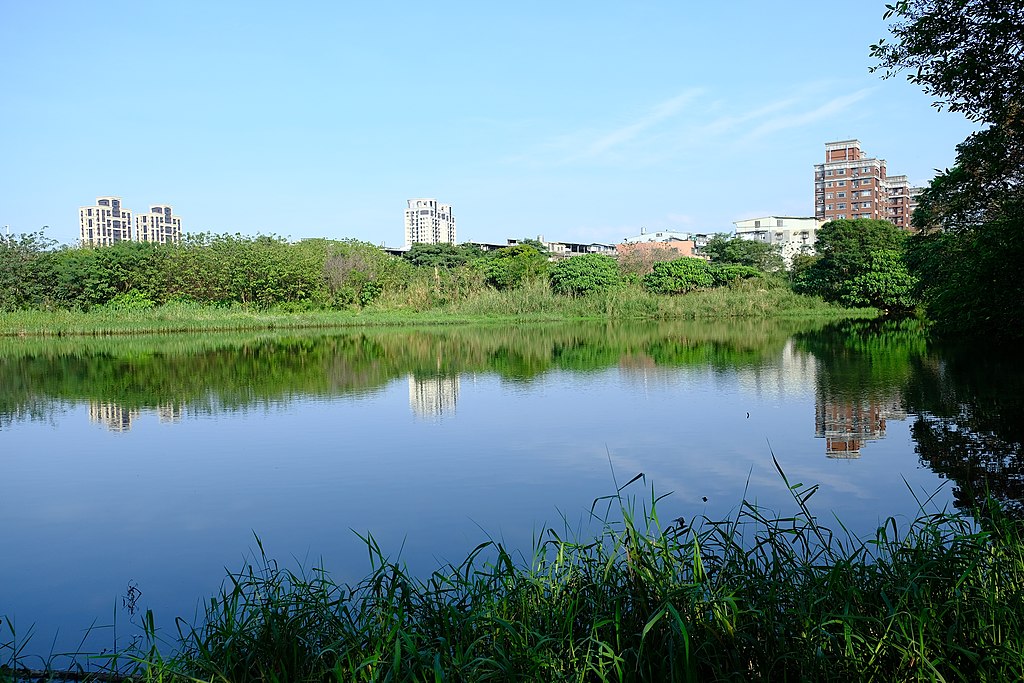A constructed wetland in Fu Zhou, China. Taiwankengo, CC BY-SA 4.0, via Wikimedia Commons
This article originally appeared in The Oxford Scientist’s Print edition in Hilary Term 2022, under the title ‘Mimicking natural processes for urban regeneration’.
Regeneration is a buzzword used frequently by city councils around England to describe schemes which aim to transform urban areas into sustainable, circular, greener places to live. This aim of regeneration, however, is seen by scientists as a serious interdisciplinary challenge. As populations continue to rise and urbanisation expands, the green spaces we have left are increasingly reduced. Our cities’ air has become polluted, and our water resource systems stressed and placed under high demand.
These challenges are exacerbated by the impacts and uncertainties of anthropogenic climate change which has given rise to more extreme weather events, for example, the more frequent and severe floods which have been seen across England in recent years. Regeneration schemes already have to tackle multiple factors such as air pollution and poor river water quality, so the added consideration of flood risk criteria creates a complex challenge. Is it possible to target all these issues with one solution?
As the regeneration of urban areas is now seen as an interdisciplinary problem with a multitude of interlinked issues, a flexible and adaptable solution is required. The complexities of poor urban air quality, river water quality, and flood risk, mean that Nature-Based Solutions (NbS) in urban areas are becoming more common—but are NbS the adaptable and flexible solution we need?
NbS describe structures which mimic natural processes. These can be constructed wetlands, constructed reedbeds, and specialised vegetation planting. In previous years, NbS such as constructed wetlands have primarily been implemented to treat wastewater, agricultural and industrial runoff. These runoff sources known as “point pollution” are more straightforward to design NbS for. Urban runoff, known as “diffuse pollution”, is harder to tackle as it contains a multitude of different pollution sources such as sewer overflow, drain water, rain-runoff from roof tops, and rubbish dumping in the streets.
NbS are artificial systems formed with planting soils, vegetation, and specific plants which can retain water and treat pollutants. These constructed natural systems which mimic natural processes are now being used for absorbing and treating the urban runoff mentioned above before it enters a city’s river (usually the main drinking water supply source!). There is also further potential for these systems to retain small flood peaks, (reducing flood risk), and for the vegetation to absorb carbon dioxide from the air.
The River Thames Basin, infamous for raw sewage release scandals, and known to be at high flood risk, is the target for multiple regeneration attempts. Many catchments of the Thames have been given ‘poor’ water quality status under the standards of the EU Water Framework Directive. In response to this failure to meet standards, catchment areas such as Salmon’s Brook and Pymmes Brook in London have begun to undergo regeneration through the installation of NbS (under the Healthy River Challenge run by Enfield Council).
In Salmon’s Brook, NbS structures have been installed to treat the raw sewage which enters the rainfall drainage system via historically misconnected sewers before it joins the brook eventually leading to the Thames basin. Historically misconnected sewers are a problem across London: years ago sewer pipes and rainfall drainage systems underground were accidentally misconnected and now contain leaks, resulting in a mixture of sewage contaminating the surface water drainage pipes which enter water sources such as the River Thames.
The NbS approach being used to tackle this has been deemed successful as an Environment Agency report in 2016 presented results showing that the NbS reduced pollutants such as ammonia, nitrogen, and phosphate. However, there has been no follow up study to look at water quality improvements over the long-term, and no flood risk or air pollution reduction testing.
Whilst NbS may seem like an easy, natural, and solve-all fix for many councils, amongst the scientific community there is concern over the lack of scientific and engineering standard testing of these structures. There is no design manual or handbook for different urban scenarios like there are for hard concrete structures such as flood defences, and there is not enough information on their lifespan, structural resistance to different flood peaks, or abilities to remove pollutants and retain them over long periods of time. There is also the concern that during severe flood events, the pollutants retained in the NbS may be released and leached back out into the environment.
NbS do offer an exciting opportunity for regenerating our urban spaces and making them more in tune with the natural environment, however, they require further research and implementation. For NbS to potentially one day be able to transform urban areas into more sustainable, circular, and green places to live, intensive research into their optimum design for different city scenarios is needed.





